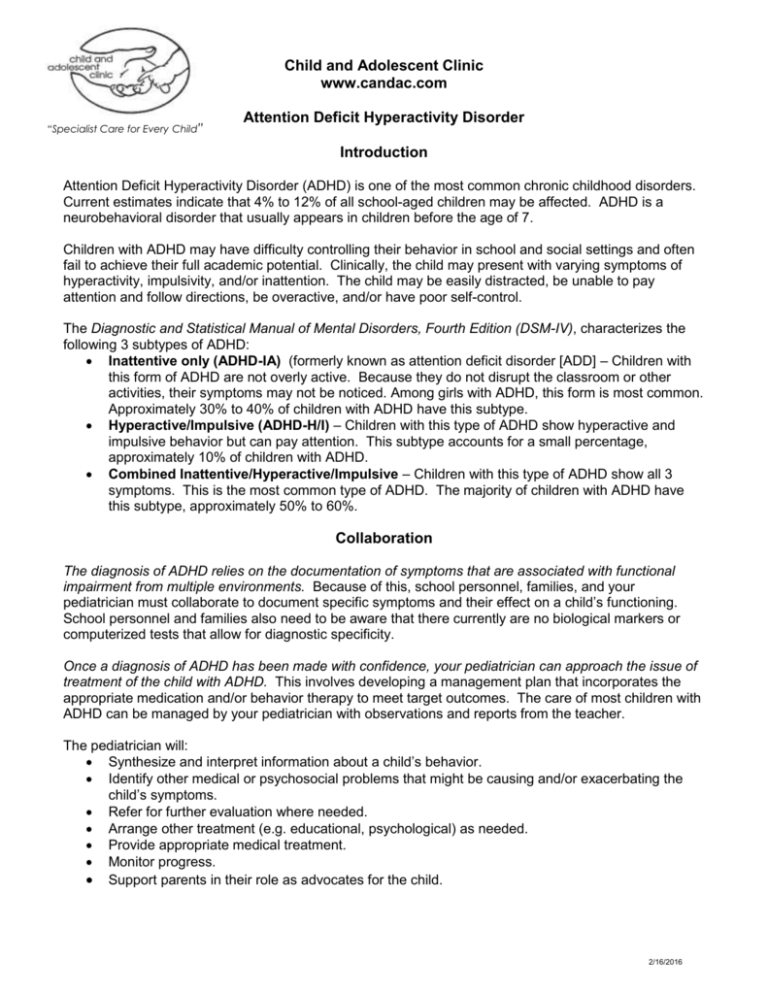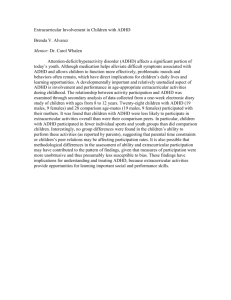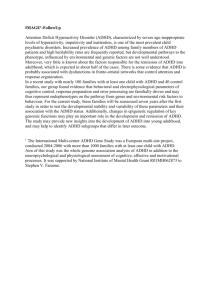Evaluation - The Child & Adolescent Clinic
advertisement

Child and Adolescent Clinic www.candac.com “Specialist Care for Every Child” Attention Deficit Hyperactivity Disorder Introduction Attention Deficit Hyperactivity Disorder (ADHD) is one of the most common chronic childhood disorders. Current estimates indicate that 4% to 12% of all school-aged children may be affected. ADHD is a neurobehavioral disorder that usually appears in children before the age of 7. Children with ADHD may have difficulty controlling their behavior in school and social settings and often fail to achieve their full academic potential. Clinically, the child may present with varying symptoms of hyperactivity, impulsivity, and/or inattention. The child may be easily distracted, be unable to pay attention and follow directions, be overactive, and/or have poor self-control. The Diagnostic and Statistical Manual of Mental Disorders, Fourth Edition (DSM-IV), characterizes the following 3 subtypes of ADHD: Inattentive only (ADHD-IA) (formerly known as attention deficit disorder [ADD] – Children with this form of ADHD are not overly active. Because they do not disrupt the classroom or other activities, their symptoms may not be noticed. Among girls with ADHD, this form is most common. Approximately 30% to 40% of children with ADHD have this subtype. Hyperactive/Impulsive (ADHD-H/I) – Children with this type of ADHD show hyperactive and impulsive behavior but can pay attention. This subtype accounts for a small percentage, approximately 10% of children with ADHD. Combined Inattentive/Hyperactive/Impulsive – Children with this type of ADHD show all 3 symptoms. This is the most common type of ADHD. The majority of children with ADHD have this subtype, approximately 50% to 60%. Collaboration The diagnosis of ADHD relies on the documentation of symptoms that are associated with functional impairment from multiple environments. Because of this, school personnel, families, and your pediatrician must collaborate to document specific symptoms and their effect on a child’s functioning. School personnel and families also need to be aware that there currently are no biological markers or computerized tests that allow for diagnostic specificity. Once a diagnosis of ADHD has been made with confidence, your pediatrician can approach the issue of treatment of the child with ADHD. This involves developing a management plan that incorporates the appropriate medication and/or behavior therapy to meet target outcomes. The care of most children with ADHD can be managed by your pediatrician with observations and reports from the teacher. The pediatrician will: Synthesize and interpret information about a child’s behavior. Identify other medical or psychosocial problems that might be causing and/or exacerbating the child’s symptoms. Refer for further evaluation where needed. Arrange other treatment (e.g. educational, psychological) as needed. Provide appropriate medical treatment. Monitor progress. Support parents in their role as advocates for the child. 2/16/2016 Diagnosis An effective treatment begins with an accurate, well-established diagnosis. This American Academy of Pediatrics clinical practice guideline contains the following recommendations for diagnosis of ADHD: 1. In a child 6 to 12 years old who presents with inattention, hyperactivity, impulsivity, academic underachievement, or behavior problems, the pediatrician should initiate an evaluation for ADHD. 2. The diagnosis of ADHD requires that a child meet Diagnostic and Statistical Manual of Mental Disorders, Fourth Edition (DSM-IV), criteria. 3. The assessment of ADHD requires evidence directly obtained from parents or caregivers regarding the core symptoms of ADHD in various settings, the age of onset, duration of symptoms, and degree of functional impairment. 4. The assessment of ADHD requires evidence directly obtained from the classroom teacher (or other school professional) regarding the core symptoms of ADHD, duration of symptoms, degree of functional impairment, and coexisting conditions. 5. Evaluation of the child with ADHD should include assessment for associated (coexisting) conditions. 6. Other diagnostic tests are not routinely indicated to establish the diagnosis of ADHD but may be used for the assessment of other coexisting conditions (i.e., Learning disabilities, mental retardation). Evaluation The above clinical practice guidelines are not intended as a sole source in the evaluation of children with ADHD. Rather, it is designed to assist pediatricians by providing a framework for diagnostic decision-making. It is not intended to replace clinical judgment or to establish a protocol for all children with the conditions. A child must meet DSM-IV criteria for a diagnosis of ADHD to be appropriate. To confirm a diagnosis of ADHD, these behaviors must: Occur in more than one setting, such as home, school, and social situations. Occur to a greater degree than in other children the same age. Begin onset before the child reaches 7 years of age and continue on a regular basis for more than 6 months. Significantly impair the child’s academic and social functioning. Not be better accounted for by another disorder. The child with ADD inattentive type may not be diagnosed by age 7 years. Many school-aged children have some of these symptoms, either transiently or in a mild form, and it is important to establish the high frequency of symptoms to make the diagnosis of ADHD. The NICHQ Vanderbilt Parent and Teacher Assessment Scales are one way to do this. The NICHQ Vanderbilt Assessment Scales also screen for the following coexisting conditions: oppositionaldefiant disorder, conduct disorder, and anxiety and depression. If a screen is positive, a more detailed evaluation is warranted. It also should be noted that the scales will not pick up learning disabilities, suicidal behaviors, bipolar disorder, alcohol and drug use, or tics – all of which may be present in a child with ADHD. 2/16/2016 Teacher Assessment Teachers often are the first to notice behavior signs of possible ADHD. Children 6 to 12 years of age spend many of their waking hours at school, and the teacher is a powerful source of information about the child's behaviors, interactions and academic performance. To make an accurate diagnosis, information about the child will be needed directly from the child's classroom teacher or another school professional. The child's academic and classroom behavior is necessary to corroborate the diagnosis and identify potential learning disabilities. The guidelines specify that this information can be obtained using narratives from the teacher or specific rating scales. Some pediatricians find it helpful to do both. In addition to using an ADHD rating scale, the pediatricians find it helpful to talk directly with the teacher to obtain richness beyond the rating scales. For example, we may ask the teacher to describe: The child's behavior in the classroom The child's learning patterns How long the symptoms have been present How long the symptoms affect the child's progress at school Ways the teacher has adapted the classroom program to help the child Whether other conditions contribute to or affect the symptoms In addition, we may ask to see report cards and samples of the child's schoolwork, as well as any formal testing performed by school personnel. This interview can take place over the phone or in the form of a written narrative or a paper or computerbased questionnaire. Treatment A treatment plan is tailored to the individual needs of the child and family. It may require medical, educational, behavioral, and psychological interventions. This multimode approach can improve the child's behavior in the home, classroom, and social settings. In most cases, successful treatment will include a combination of stimulant medication and behavior therapy. The American Academy of Pediatrics clinical practice guideline, "Treatment of the School-Aged Child With Attention Deficit Hyperactivity Disorder," contains the following recommendations for treatment of ADHD in children aged 6 to 12 years: 1. The pediatrician should establish a treatment program that recognizes ADHD as a chronic condition. 2. The pediatrician, parents, and the child, in collaboration with the school personnel, should specify appropriate target outcomes to guide management. 3. The pediatrician should recommend stimulant medication and/or behavioral therapy as appropriate to improve target outcomes in children with ADHD. 4. When the selected management for a child with ADHD has not met target outcomes, the pediatrician should evaluate the original diagnosis, use of all appropriate treatments, adherence to the treatment plan, and presence of coexisting conditions. 5. The pediatrician should periodically provide a systematic follow-up for the child with ADHD. Monitoring should be directed to target outcomes and adverse effects by obtaining specific information from parents, teachers, and the child. The American Academy of Pediatrics guidelines recognize the variation in severity and complexity of children presenting with ADHD and specifically limits the target population to children aged 6 to 12 years with ADHD, but without major coexisting conditions. 2/16/2016








